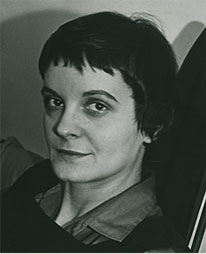 |
elizabeth delson 1962 |
Liz also pursued the community service aspects of art. She was a co-founder of the Park Slope Annual Art Exhibitions, a charter member and treasurer of the Contemporary Artists Guild, and served on the board of directors of the Brooklyn Museum Community Gallery. When her Park Slope neighborhood was nominated for designation as an Historic District, she wrote the architectural narrative description of each house in the two historic blocks of Third Street where she lived. She also wrote for the Prospect Park Centennial Celebration the narrative history of the noted artists who had painted scenes of Prospect Park. Liz did all this while being a full-time artist and a stay-at-home mom to Karen, Sara and Matthew.
Liz’s strong interest in visual art scholarship, historical and contemporary, is reflected in the impressive art library she collected and in her own approach to art. Her delight in lyrical architecture and design: Gaudi, Gehry, Calatrava and the practitioners of Art Nouveau, can be seen in her own work. Her strong interest in classical literature and in mythology is evident in her work and in the titles of her work (Liz never called a work “untitled”; titles were very important to her).
In 1972 Liz completed her work for a master’s degree at Hunter College. Part of her thesis was her portfolio suite of color etchings Twelve Tribes of Israel. During the 1970s and 80s nineteen of her works were acquired by institutional collections, including her portfolio suite of etchings Metamorphoses by the New York Public Library. She continued to produce commissioned editions of etchings for Associated American Artists, the Calvin Collection and others. In 1976, with the money she earned from commissioned editions, Liz had Charles Brand build her a new large etching press, which was her pride and joy. Unlike many printmakers, Liz printed all her work, including editions, herself (except for a large edition for Associated American Artists). She felt that the printing process was part of the art. In 1996 Liz was awarded her second Audubon Artists Gold Medal of Honor for her color viscosity etching Drift.
In 1999, prompted by a fall in which Liz broke her knee (which Liz called “the lucky break”), the Delsons realized that a four story house with all those stairs was no longer a good idea. They sold their Park Slope house, built a new studio behind their vacation house in East Hampton, New York, and Liz started life anew in the large and active community of artists on the East End of Long Island. She quickly entered into the community life of East Hampton artists. For three years, she was treasurer of the Artists Alliance of East Hampton and was also on its board of directors. She participated in local group exhibitions while continuing to show her work in juried and group exhibitions in Manhattan. In 2002, Liz had a solo exhibition at the Clayton & Liberatore Gallery in Bridgehampton, New York.
Although Liz installed her cherished Charles Brand etching press in her new studio, she did not bring the acid required for conventional etching to East Hampton because she knew the disposal of acid, even when neutralized, into the groundwater of Long Island was unwise. In 2000 she and her husband spent a month in Florence, Italy, to learn the solarplate etching process in a workshop conducted by Dan Welden. Liz did not like the solarplate process because it does not permit working the plate and experimenting with several states as conventional acid etching does. Although she made a number of solarplate etchings in the next few years, her attention turned to the paintings described at the beginning of this biographical narrative.
In 2004 Liz joined a group of artists – all of them younger – forming an artists’ cooperative gallery at the Crazy Monkey Gallery in Amagansett, New York. It was a very congenial group and Liz enjoyed the pace and variety of the monthly exhibitions, which prompted her to happily work more intensively.
In February 2005, Liz was diagnosed with an aggressive form of metastasized lung cancer. Although it was a terrible shock, and the chemotherapy treatment was grueling, she refused to let it defeat her even though she knew it would kill her. She continued to participate in the monthly Crazy Monkey Gallery exhibitions, attend local theater performances and travel into Manhattan for theater and her beloved opera. Not once did she complain about her illness or its effect on her life. Liz completed four paintings in 2005 and had four more in progress. In her last newspaper interview, she said:
I begin my paintings with gesso on heavy watercolor paper and glaze the image with transparent layers of oil paint to achieve a magical luminosity. Based on nature, especially the beaches, I look behind the actual appearance to crystallize a moment or a mood, to share its vitality and meaning with others. (Dan’s Papers, March 18, 2005)
In September 2005 the Crazy Monkey Gallery arranged a solo exhibition of her work scheduled to open at the end of the month. Liz planned in detail the installation of the eight paintings and eight etchings, and looked forward to the opening at the end of that week. The night before the opening, Liz became seriously ill and spent three days in the Southampton Hospital ICU. Although she missed the opening, she was pleased by the response of those who attended and by the reported reaction of the newspaper reviewer.
On Monday October 3, 2005, Liz returned to her home under hospice care. She died that evening.
Elizabeth Delson was an artist of uncommon talent, skill, vitality and curiosity who was totally committed to the importance of art as an expression of life.
She was a woman of uncommon beauty, modesty, grace and courage.
And she was my beloved wife for fifty years.
Sidney L. Delson, FAIA
East Hampton, New York
February 2007 |